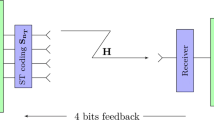Abstract
The problem of designing space-time constellations for communication in spread multiple-antenna wireless systems over Rayleigh fading channel is addressed. Using the asymptotic union bound on error probability as design criterion, codes based on general complex-valued symbols are obtained with a gradient search optimization technique. New space-time constellations are constructed and their performance is assessed. Simulation results show that the proposed technique achieves significant performance gains over existing schemes. Since the designed codebooks do not seem to possess any structure that could reduce the memory requirements for storing the corresponding codebook, the problem of designing structured space-time constellations is also addressed. To overcome this problem, a discrete Fourier transform-based approach is adopted to design structured codebooks and their performance is evaluated. The new structured codebooks also demonstrate significant improvement over state-of-art structured schemes.
Similar content being viewed by others
References
Murch R. D., Letaief K. B. (2002) Antenna systems for broadband wireless access. IEEE Communications Magazine 40(4): 76–83
Alamouti S. A. (1998) A simple transmit diversity technique for wireless communication. IEEE Journal Selected Areas in Communications 16: 1451–1458
Tarokh V., Seshadri N., Calderbank A. (1998) Space-time codes for high data rate wireless communication: Performance criterion and code construction. IEEE Transactions on Information Theory 44(2): 744–765
Foschini G. J. (1996) Layered space-time architecture for wireless communication in a fading environment when using multi-element antennas. Bell Labs Technical Journal 1(2): 41–59
Foschini G. J., Gans M. (1998) On the limits of wireless communication in a fading enviroment when using multiple antennas. Wireless Personal Communications 6(3): 311–335
Tarokh V., Jafarkhani H., Calderbank A. R. (1999) Space-time block codes from orthogonal designs. IEEE Transactions on Information Theory 45(5): 1456–1467
Hochwald B. M., Marzetta T. L. (2000) Unitary space-time modulation for multiple-antenna communication in Rayleigh flat-fading. IEEE Transactions on Information Theory 46: 543–564
Geng, J., Mitra, U., & Fitz, M. P. (2001). Space-time block codes in multipath CDMA systems. In Proceeding of IEEE ISIT (p. 151), Washington, USA.
Geng J., Mitra U. (2006) Nonlinear hierarchical space-time block codes: Construction and regular MTCM design. IEEE Transactions on Communications 54(1): 82–95
Vajapeyam M., Geng J., Mitra U. (2007) Tools for performance analysis and design of space-time block codes. IEEE Transactions on Communications 55(2): 367–379
Beko, M., Xavier, J., & Barroso, V. (2009). Codebook design for communication in spread and nonspread space-time block codes-based systems. In Proceeding of IEEE ISWCS, Siena, Italy.
Hochwald B. M., Marzetta T. L., Richardson T. J., Sweldens W., Urbanke R. (2000) Systematic design of unitary space-time constellations. IEEE Transactions on Information Theory 46(6): 1962– 1973
Schlegel C. (1996) Error probability calculation for multibeam Rayleigh channels. IEEE Transactions on Information Theory 44(2): 290–293
Verdú S. (1998) Multiuser detection. Cambridge University Press, Cambridge
Bolcskei, H., & Paulraj, A. J. (2000). Space-frequency coded broadband OFDM systems. In Proceeding of IEEE WCNC (pp. 1–6). Chicago, IL.
Scharf L. L. (1990) Statistical signal processing: Detection, estimation, and time series analysis. Addison-Wesley Publishing Co, New York
Proakis J. (2000) Digital communication. McGraw Hill, New York
Candreva, E. A., & Corazza, G. E. (2010). A tighter upper bound on the error probability of signals in white Gaussian noise. In Proceeding of ASMS-SPSC, pp. 444–448.
Dianjun, C., Yue, L., & Hashimoto, T. (2009). A new performance bound for non-orthogonal space-time spreading CDMA systems over MIMO Rayleigh fading channels. In Proceeding of IEEE PIMRC, pp. 531–535.
Nocedal, J., & Wright, S. J. (1999). Numerical optimization. Springer. Series in Operations Research.
Polak E. (1997) Optimization: Algorithms and consistent approximation. Springer, Berlin
Magnus J. R., Neudecker H. (1999) Matrix differential calculus with applications in statistics and econometrics. Revised edition. Wiley, New York
Horn R. A., Johnson C. R. (1985) Matrix analysis. Cambridge University Press, Cambridge
Boyd S., Vandenberghe L. (2004) Convex optimization. Cambridge University Press, Cambridge
Larsson E. G., Stoica P. (2003) Space-time block codes for wireless communications. Cambridge University Press, Cambridge
Author information
Authors and Affiliations
Corresponding author
Rights and permissions
About this article
Cite this article
Beko, M., Dinis, R. Space-Time Codebook Design for Spread Systems. Wireless Pers Commun 69, 1783–1797 (2013). https://doi.org/10.1007/s11277-012-0663-x
Published:
Issue Date:
DOI: https://doi.org/10.1007/s11277-012-0663-x




